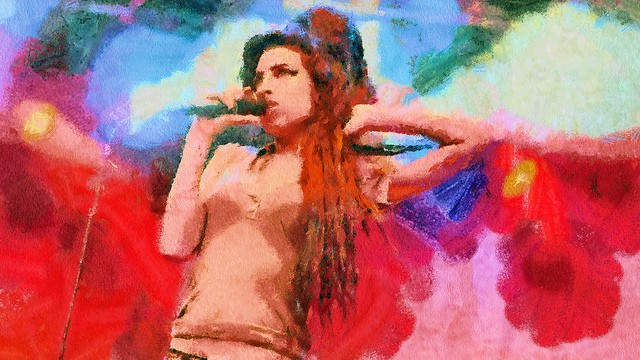There are some music albums that become the soundtracks for particular moments in our lives. You know the kind I mean: the ones where simply hearing one of its songs – even years later – transports you instantaneously to a particular moment in the past.
Amy Winehouse’s “Back to Black” is one of those albums for me. When I hear its songs, I flash back to the spring of 2007 in Washington, D.C. I was a young man in a big city with a job and little money to spend (emphasis on ‘little’). These were my ‘wander years,’ the time where the personal compass recalibrated after graduating from college. Who did I want to be – and what did I want to do – when I grew up? Since I was suddenly a grown up, at least in the eyes of the IRS, this question felt freshly urgent.
Winehouse’s voice and music were irresistible to me. They married the sounds of the ‘oldies’ of my childhood with searing transparency about, well, things many a 22-year old can relate to: booze, drugs, sex, love, and heartache (occasionally in that order, though not always).
I was sad when Winehouse died of alcohol poisoning in 2011, enfeebled as she was by a longstanding battle with bulimia. Sad, but not surprised, having seen the media’s coverage of their favorite girl-gone-wild even after I entered the Jesuits in 2008.
***
Asaf Kapadia’s documentary about Winehouse, “Amy,” was released in early July. It is a tender – even intimate – look at the life and music of a truly remarkable artist. Kapadia has curated an impressive trove of videos and photographs of Amy and her inner circle, ranging from private home movies to paparazzi shots of her final years. The story is told not by an omniscient narrator but by interviews: archived conversations with Amy and present-day reflections from people that knew and loved the troubled performer. Many of their remarks betray the ‘what if’ handwringing and second-guessing that is left to the living after a friend’s demise.
The film was riveting, and it was heartbreaking.
It is not uncommon for musicians to say that they are in it “for the music,” not the fame. Such protestations usually seem disingenuous at best and ludicrous at worst. But these words didn’t ring hollow coming from Winehouse’s mouth. Her raw and raucous music and personal life notwithstanding, she seemed transparently uncomfortable – shy, even – in many of the interviews Kapadia assembled. The attention showered upon her, particularly after the release of “Back to Black,” had the air of intrusion. It seemed to distract from her love of music.
The film has stirred no little controversy. Though originally approved by Winehouse’s family, the biopic has come under intense criticism – particularly from Mitch Winehouse, Amy’s father. Those who have seen it, or who have followed Amy’s story elsewhere, will understand exactly why: if Amy is the beleaguered hero of the story, her father is often pegged as the archetypal villain. Absent during her childhood, he seems to magically reappear in time to help manage (and therefore profit from) her meteoric rise. Ever the object of his daughter’s love, the film not-so-subtly queries whether he put his own varied interests before the health and even life of his daughter. His now-disputed remark “She doesn’t need to go to rehab” seems a kiss of death in retrospect. It also informed Amy’s Grammy-winning protestation: “my daddy thinks I’m fine.”
Full disclosure: I think Mitch Winehouse did very little to stop his daughter’s demise, and I think he benefitted from it in ways (career, wealth) that should be and likely are sources of intense regret. The aggrieved father’s promise to make his own documentary about Amy seems, on an uncharitable reading, to merely reinforce the impression that this is all about him.
But if we’re honest, it’s easy to judge other people’s parenting, especially in hindsight. Doing so is not the point of this piece. I don’t think it’s the point of Kapadia’s film, either. The truth is, Amy seemed to have an abundance of possible villains in her life: some familial, some of her choosing (like her especially degenerate ex-husband Blake Fielder-Civil), and some the consequence of her musical success. And this is to say nothing of her own demons. In the end, if the combined chaos of her life was a boulder, it was barrelling downhill too fast for her father – or anyone else – to stop alone.
***
Even if the blame game resists easy conclusion, I still found the question “Who killed Amy Winehouse?” to be the unavoidable if implicit heart of the documentary. And none of the possible answers – herself, her addictions, the neglect and even abuse of family and friends, the pressures of fame – seems entirely satisfying. More disturbingly, there is a way that the film implicates Amy’s fans, myself included, in the trajectory not only of her stardom but also of her downfall.
The latter half of the film relies on paparazzi video and photography, even as it chronicles the ways that the constant media attention compounded Winehouse’s existing troubles. Those photos fed a hungry public’s taste for the latest Winehouse gossip. I’m no economist, but I get that supply follows demand.
Complaints about paparazzi and media feeding frenzies are not new. Nor are they unique to Winehouse. But neither fact should comfort us. No matter the identity of the celebrity or public personage, the paparazzi depends on a market for its wares, and the publishing media depends on consumers (that would be us) prepared to be shocked, intrigued, or titillated by them. And as we have seen in so many cases by now, this is a system that both generates fame and helps break the famous – that is, once their celebrity no longer enchants us. Amy Winehouse was no exception.
Since 2007, I knew I was a consumer of her music. I left the theatre in 2015 distressed, wondering if what I had consumed, with millions of others, was really Amy herself.
***
Many have commented that it became impossible to listen to Winehouse’s hit single “Rehab” in the same way once we realized that she was literally drinking herself to death. Lord knows that’s true, but the sentiment rings a little hollow. Even when she was alive and eventually entered treatment for alcohol and drug addiction, jokes about Winehouse saying “Yes, Yes, Yes” to rehab seemed more prevalent than genuine care. Her erstwhile husband, who was in rehab with her (for reasons surpassing understanding), makes a similar joke in the film.
Forget “Rehab.” The song that haunts me is her posthumously-released cover of “Will You Still Love Me Tomorrow?” Knowing her story, the 1960 hit by The Shirelles takes on an entirely different aspect.
The song is about a different relationship than the one between a singer and her fans, it’s true. But it came to my mind repeatedly in the theatre, and especially as Kapadia showed footage of Winehouse’s last concert in Belgrade, mere days before her death. Greeted by uproarious applause upon taking the stage, an impaired Amy was unable (or unwilling, or perhaps both) to perform. The cheers turned to jeers almost instantaneously. Nothing would have been more appropriate for that crowd, and for many others, than if Winehouse had sung that haunting, searching song:
Tonight you’re mine completely
You give your love so sweetly
Tonight the light of love is in your eyes
Will you still love me tomorrow?
And even as I wish she would have sung it, to have this song be our last live memory of her, I can barely stand to hear her intone its yearning and vulnerability, its desire for love. The answer to her questions, I’m afraid, was: “No.”
To see this film is to realize that this elusive love is exactly what she wanted – especially from her family, friends, and lovers – and too rarely received it. To see “Amy” is to know, again and with renewed urgency, that public acclaim and genuine love are two very different things.
She lived life until it killed her. She sought love until it broke her. She sang for us, giving words where once we had none. We helped consume her.
May we now mourn for her. And may she rest in peace.
–//–
The cover image, “The Chaotic World of Amy Winehouse,” is by Steve Taylor via flickr.


